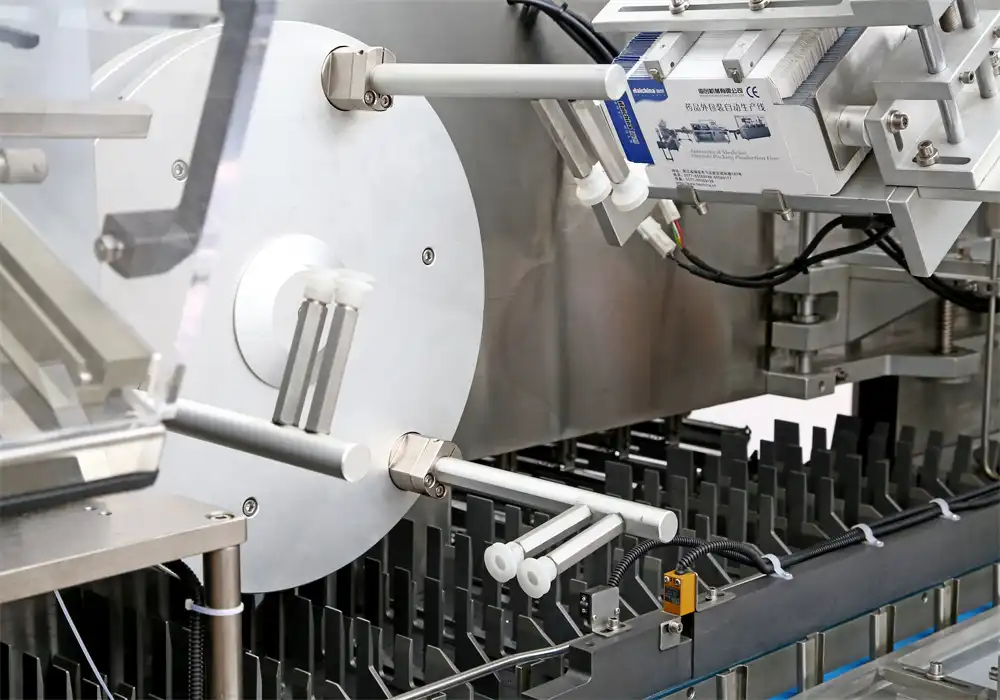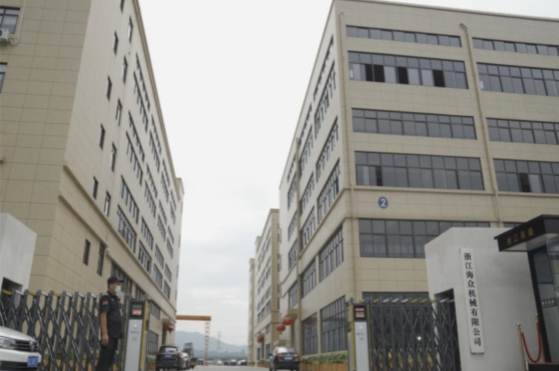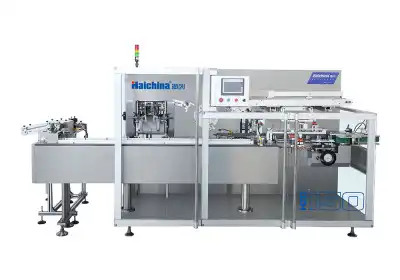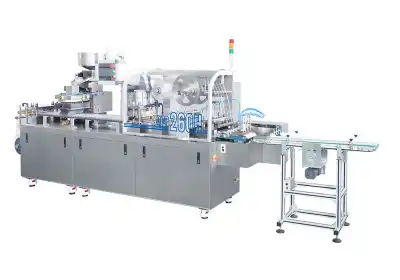Flat Forming vs. Thermoforming Blister Machines
When it comes to choosing between flat forming and thermoforming blister machines, understanding the nuances of each technology is crucial for selecting the optimal automatic blister packing machine for your production needs. Flat forming machines utilize pre-formed blisters and are ideal for simpler packaging designs and smaller production runs. On the other hand, thermoforming machines create blisters from rolls of plastic film, offering greater flexibility in blister design and higher production speeds. Both types of machines have their strengths, and the choice between them depends on factors such as product characteristics, production volume, packaging design complexity, and budget considerations. Let's delve deeper into the world of blister packaging to help you make an informed decision for your packaging requirements.

The Mechanics of Flat Forming and Thermoforming Blister Machines
Understanding Flat Forming Technology
Flat forming blister machines operate by using pre-formed blisters, which are typically made of PVC or PET materials. These machines are designed to handle ready-made blisters, making them an excellent choice for companies with standardized packaging requirements. The process involves placing the product into the pre-formed cavity, sealing it with a backing card or foil, and then cutting the individual blisters. This method is particularly advantageous for businesses that require quick changeovers between different product lines or have limited space for equipment.

Exploring Thermoforming Technology
Thermoforming blister machines, in contrast, create blisters on-demand from rolls of plastic film. This process involves heating the plastic material, forming it into the desired shape using molds or air pressure, cooling it to retain its form, and then proceeding with product insertion and sealing. Thermoforming offers greater flexibility in blister design, allowing for custom shapes and sizes to be produced in-line. This technology is particularly beneficial for high-volume production and products that require unique packaging solutions, especially when using an automatic blister packing machine.

Comparing Operational Efficiency
When evaluating operational efficiency, both types of machines have their merits. Flat forming machines generally have quicker setup times and are easier to operate, making them suitable for smaller production runs or frequent product changes. Thermoforming machines, while potentially requiring more initial setup, excel in continuous high-volume production scenarios. The choice between the two often comes down to balancing production needs with operational capabilities and resource allocation.

Key Considerations for Selecting the Right Blister Packaging Solution
Assessing Product Characteristics
The nature of the product being packaged plays a significant role in determining the most suitable blister packing machine. Flat forming machines are often preferred for products with simple geometries or those that require minimal protection. Thermoforming machines, with their ability to create custom-shaped blisters, are ideal for products with irregular shapes or those needing enhanced protection. Consider factors such as product fragility, size variability, and presentation requirements when making your decision.
Evaluating Production Volume and Speed
Production volume is a critical factor in choosing between flat forming and thermoforming technologies. Flat forming machines are well-suited for small to medium production runs, offering flexibility and quick changeovers. For high-volume production, thermoforming machines typically offer superior speed and efficiency, capable of producing thousands of units per hour. Assess your current production needs and future growth projections to ensure the selected machine can meet both immediate and long-term requirements.
Analyzing Cost Implications
Cost considerations extend beyond the initial investment in the automatic blister packing machine. Flat forming machines generally have a lower upfront cost and may be more economical for businesses with modest production needs. Thermoforming machines, while potentially more expensive initially, can offer cost savings in the long run for high-volume production through reduced material costs and increased efficiency. Factor in operational costs, maintenance requirements, and potential scalability when evaluating the total cost of ownership for each option.
Optimizing Packaging Design and Material Selection
Innovating Blister Designs
The flexibility in packaging design is a significant advantage of thermoforming technology. This method allows for the creation of complex blister shapes, multi-cavity designs, and even integration of special features like tamper-evident seals or reclosable options. Flat forming machines, while more limited in design flexibility, can still accommodate a wide range of standard blister shapes and sizes. Consider your product's branding requirements, display needs, and consumer interaction when deciding which technology aligns best with your packaging design goals.
Selecting Appropriate Materials
Material selection is crucial for both flat forming and thermoforming processes. Flat forming machines typically work with PVC, PET, or similar pre-formed materials, offering a range of thicknesses and clarity options. Thermoforming machines can utilize a broader spectrum of materials, including PVC, PET, PETG, and even biodegradable options, providing greater flexibility in meeting sustainability goals or specific product protection requirements. The choice of material impacts not only the packaging's appearance and functionality but also its cost and environmental footprint.
Ensuring Quality and Compliance
Regardless of the chosen technology, ensuring the quality of the final packaging and compliance with industry standards is paramount. Both flat forming and thermoforming machines can be equipped with quality control features such as vision systems for defect detection or seal integrity checks. When selecting an automatic blister packing machine, consider the available quality assurance mechanisms and their compatibility with your industry's regulatory requirements, especially for pharmaceutical or medical device packaging.
Conclusion
Choosing between flat forming and thermoforming blister machines requires careful consideration of various factors, including product characteristics, production volume, packaging design requirements, and budget constraints. While flat forming machines offer simplicity and flexibility for smaller operations, thermoforming machines provide unparalleled design freedom and efficiency for high-volume production. By thoroughly evaluating your specific needs and future growth plans, you can select the automatic blister packing machine that best aligns with your packaging goals, ensuring optimal efficiency, quality, and cost-effectiveness in your packaging operations.
Contact Us
Ready to elevate your packaging process? Contact Zhejiang Haizhong Machinery Co.,Ltd. at [email protected] to discuss how our expert team can help you choose the perfect blister packing solution for your unique needs.
References
Johnson, R. (2022). Advances in Blister Packaging Technology: A Comprehensive Review. Journal of Packaging Science and Technology, 35(2), 112-128.
Smith, A., & Brown, B. (2021). Comparative Analysis of Flat Forming and Thermoforming Processes in Pharmaceutical Packaging. International Journal of Pharmaceutical Sciences, 56(4), 289-302.
Zhang, L., et al. (2023). Sustainability in Blister Packaging: Material Innovations and Process Efficiencies. Sustainable Packaging Solutions, 18(3), 201-215.
Wilson, E. (2020). Quality Assurance in Automated Blister Packaging: Best Practices and Emerging Technologies. Quality Control in Pharmaceutical Manufacturing, 42(1), 78-93.
Garcia, M., & Lee, K. (2022). Economic Analysis of Blister Packaging Technologies: A Case Study Approach. Journal of Industrial Engineering and Management, 29(2), 156-170.
Patel, S. (2021). Design Innovations in Blister Packaging: Meeting Consumer Needs and Regulatory Requirements. Packaging Design and Technology Review, 14(4), 234-249.

Submit the form now to get a unique quote!

ZHEJIANG HAIZHONG MACHINERY CO., LTD.
Popular Blogs
-
 Successful caseProducts and services
Successful caseProducts and servicesHow to Train Employees to Operate a Bottle Packing Machine Effectively?
-
 Successful caseIndustry insights
Successful caseIndustry insightsThe Blister Packaging Process: A Complete Step-by-Step Guide
-
 Successful caseComparative analysisIndustry insights
Successful caseComparative analysisIndustry insightsWhat Type of PVC Is Best for Blister Packing Machines?